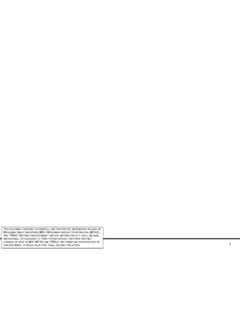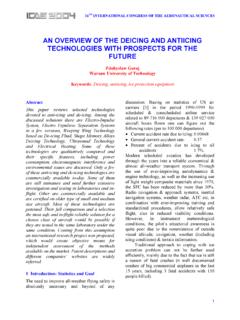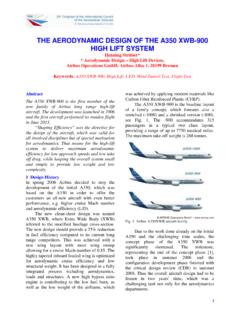Transcription of Primary Aircraft Structures Composite Application Challenge
1 MHI Proprietary NA241316. Composite Application Challenge in Primary Aircraft Structures ICAS Workshop 2011. September 5th , 2011. Toshio Abe 1. MHI Proprietary NA241316. Outline Composite Application Challenge in Primary Aircraft Structures Composite Application on airframe has been increasing. Typical examples are Boeing 787 & A350 XWB. Composite can not be demonstrated prominent advantage in cost & weight in small commercial airplane, such as MRJ. Summarizing * Technical Challenge against weight reduction * Recurring cost Challenge Need game-changing technology for obtaining prominent advantage 2. MHI Proprietary NA241316. Scope Composite Technology is one of most important technologies for lowering operation cost on commercial Aircraft .
2 Latest Airplanes are boasting to utilize their owned Composite technologies for satisfying the customer needs. Followings are examples of the new comers. * Boeing 787. * Airbus A350 XWB. * Bombardier CSeries * Mitsubishi MRJ. All have Composite wing except MRJ. Composite Application on MRJ is empennage and control surface, amounting to 10 - 15% of the total airframe weight. 3. MHI Proprietary NA241316. Composite Application on Airframe Boeing 787 (Example). Reference from, (Boeing), Fracture Analysis for bondlines and interfaces of Composite Structures . Structures , 4th International Conference of Composite testing & model identification, identification, , 2008. 4. MHI Proprietary NA241316. MRJ Aluminum decision on wing structure In addition, with the updated design the MRJ will feature an aluminum wing box, which will make it easier to manufacture the optimal wing structure .
3 Easier optimization means enhanced competitiveness across the MRJ family: the MRJ70, the MRJ90 and the MRJ stretch version, a 100-seat jet, which is a recently announced potential addition that we are excited to tell you about in greater detail below. The aluminum wing box will allow for a shorter lead-time to make structural changes, and with an aluminum wing box, the wings can be optimized to match the attributes of each member of the MRJ airplane family. This will maximize the performance of all MRJ models, including the possible stretch version. MRJ HP Posted on September 9th , 2009. Plainly speaking, Composite can not be demonstrated prominent advantage in cost & weight point against conventional Al-alloy structure just in case 90seat-class single aisle regional jet.
4 Today's Discussion is focusing on : Composite Application Challenge derived from MHI lesson & learned 5. MHI Proprietary NA241316. MHI Composite Application History 1980 1990 2000 2010 . Maiden 1983 T-2 CCV 1995 F-2 2009 787 2012 MRJ. Flight 1m 30m 5m T-2 CCV Canard 22m Composite Skin F-2 Wing-Box Co-cured structure Same Scale F-2 Wing Boeing 787 MRJ Empennage Wing-Box A-VaRTM. Co-bond structure Co-bond structure Note) T-2 CCV and F-2 Photos Ref. from Japan MOD HP. Boeing 787 Image Ref. from Boeing HP. MRJ Image Ref. from MRJ HP :Fuel Tank Area 6. MHI Proprietary NA241316. Why Composites ? Reduces Weight Reduces maintenance costs Reduces / Eliminates corrosion Better fatigue characteristics Al-alloy have been improving mechanical characteristics and still holds advantage on material / manufacturing cost.
5 Reducing total operational cost is critically important for the customer. A/C. Ownership Maintenance Fuel Ref. from IATA OCRI(=Operational Cost Reduction Initiative) bulletin 7. MHI Proprietary NA241316. Composite Contribution Composite Application contributes following factors on total operating costs. Fuel - Light weight structure contributes low fuel consumption Fuel interpreted as Light Weight in this presentation Maintenance - Better fatigue characteristics / Less susceptibility on corrosion contributes less maintenance cost and guarantees longer inspection interval A/C Ownership - < Disadvantage for Composite structure ? >. A/C Ownership interpreted as Competitive Price Product . in this presentation Reference Fuel efficiency on Boeing 787.
6 The airplane will use 20 percent less fuel for comparable missions than today's similarly sized airplane. (From Boeing HP). Reference Fuel efficiency on GEnX. A/C The GEnx will deliver 15 percent better specific Ownership fuel consumption than the engines it replaces (From HP). Maintenance Fuel Ref. from IATA OCRI(=Operational Cost Reduction Initiative) bulletin 8. MHI Proprietary NA241316. Light Weight structure Key aim of Composite Application is to realize light weight structure . Properties on today's typical Composite for Primary structure is shown below. Note: 350 MPa is an allowable value for typical Al-alloy considering fatigue knockdown. Composite strength shown below is good enough to realize low weight structure counting on advantage of material density.
7 Roughly speaking, 10 through 15% weight reduction is realized for almost modern developed airplane. This weight reduction capability is questioned for small, single-aisle airplane due to several technical challenges . Table Typical mechanical properties of Composite material Note) A-VaRTM is material & process for MRJ empennage structure . Prepreg(T800S/3900-2B) is an identical material of Application on Boeing 787 structure . Ref. from, , et al, A-VaRTM for Primary Aircraft Structures , Int. Conf. SAMPE Europe, Paris, 2006. 9. MHI Proprietary Technical challenges Light Weight structure NA241316. Technical challenges based on today's Composite technology . Due to following technical challenges , weight reduction opportunity can not be fully utilized.
8 Impact Damage strength regression Bolted Joint Stress Concentration Inter-laminar Failure / Delamination / Disbond Ply Drop-off Note that Post-buckling design is an issue for future Composite Challenge . Need advance in material / process and design manner / failure criteria for achieving the post-buckled structure . 10. MHI Proprietary Technical challenges Light Weight structure NA241316. Impact Damage strength regression Failure - Test: Impact locations 3850 micro-strain on panel (Energy 136J). Without structure Redundancy Failure - Test: 4250 micro-strain Impact With structure Redundancy Damaged Area Single Stringer Compression defined by NDI Multi-Stringer Co-bonded Panel Compression Edge Strength capability deteriorates dramatically Impact due to impact damage even in using today's toughened resin system Composite .
9 Ref. from, , et al, A-VaRTM for Primary Aircraft Structures , Int. Conf. SAMPE Europe, Paris, 2007. 11. MHI Proprietary Technical challenges Light Weight structure NA241316. Bolted Joint Bolted joint is also a weak point on Composite structure . Even in applying the premium priced toughened resin Composite , bearing strength demonstrates 40% lower than conventional Al-Alloy. 40% lower strength than conventional Bearing strength comparison between typical Al-alloy & Composite Al-alloy Al-Alloy Typical toughened resin 7050-T7451 Plate (AMS4050) Composite 980 MPa 600 MPa (e/D= , t= ) considering environmental knockdown Net-section failure Bearing failure Shear-out failure Pull-through failure Typical failure modes on fastener joints 12.
10 MHI Proprietary Technical challenges Light Weight structure NA241316. Stress concentration Stress concentration, such as hole, fillet, also deteriorate strength and needs additional thickness = weight. Compared with metallic structure , Composite needs more thickness. Comparison . Metal, or Al-alloy Ductile Significant deformation / load re-distribution prior to final failure Composite Brittle Minor permanent deformation prior to failure Bunch of Man-holes are placed in lower skin Wing-box Structural Test Article (Ref. Bombardier HP). 13. MHI Proprietary Technical challenges Light Weight structure NA241316. Inter-laminar Failure / Delamination / Disbond These failure modes are unique for Composite structure and have became our Achilles' heel on modern Composite Structures .














